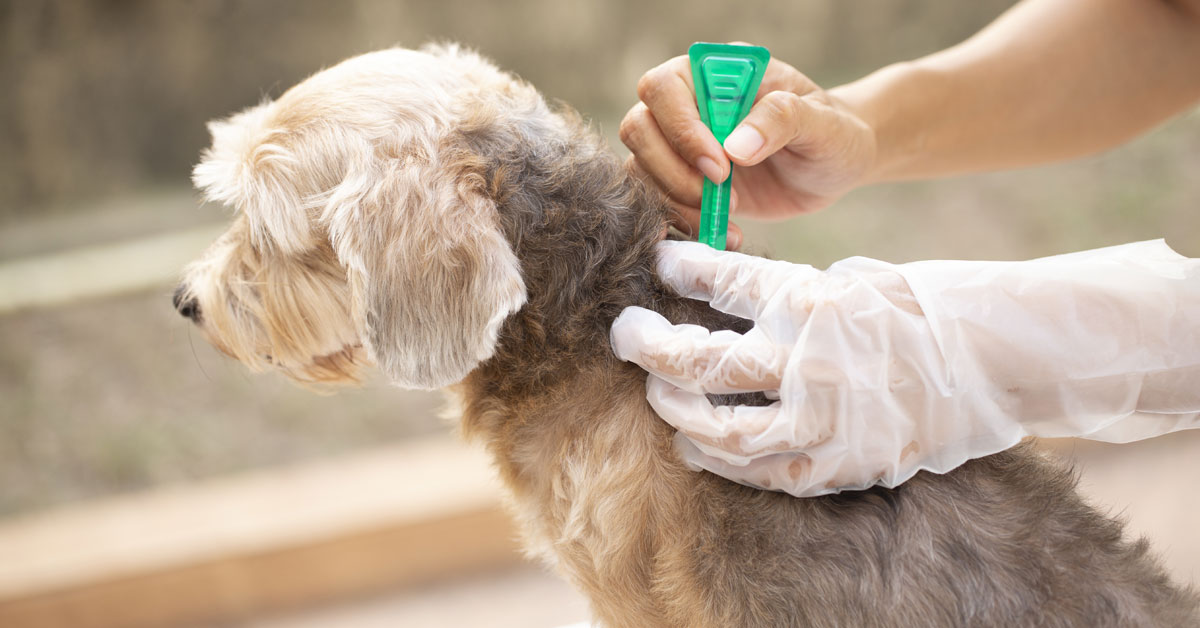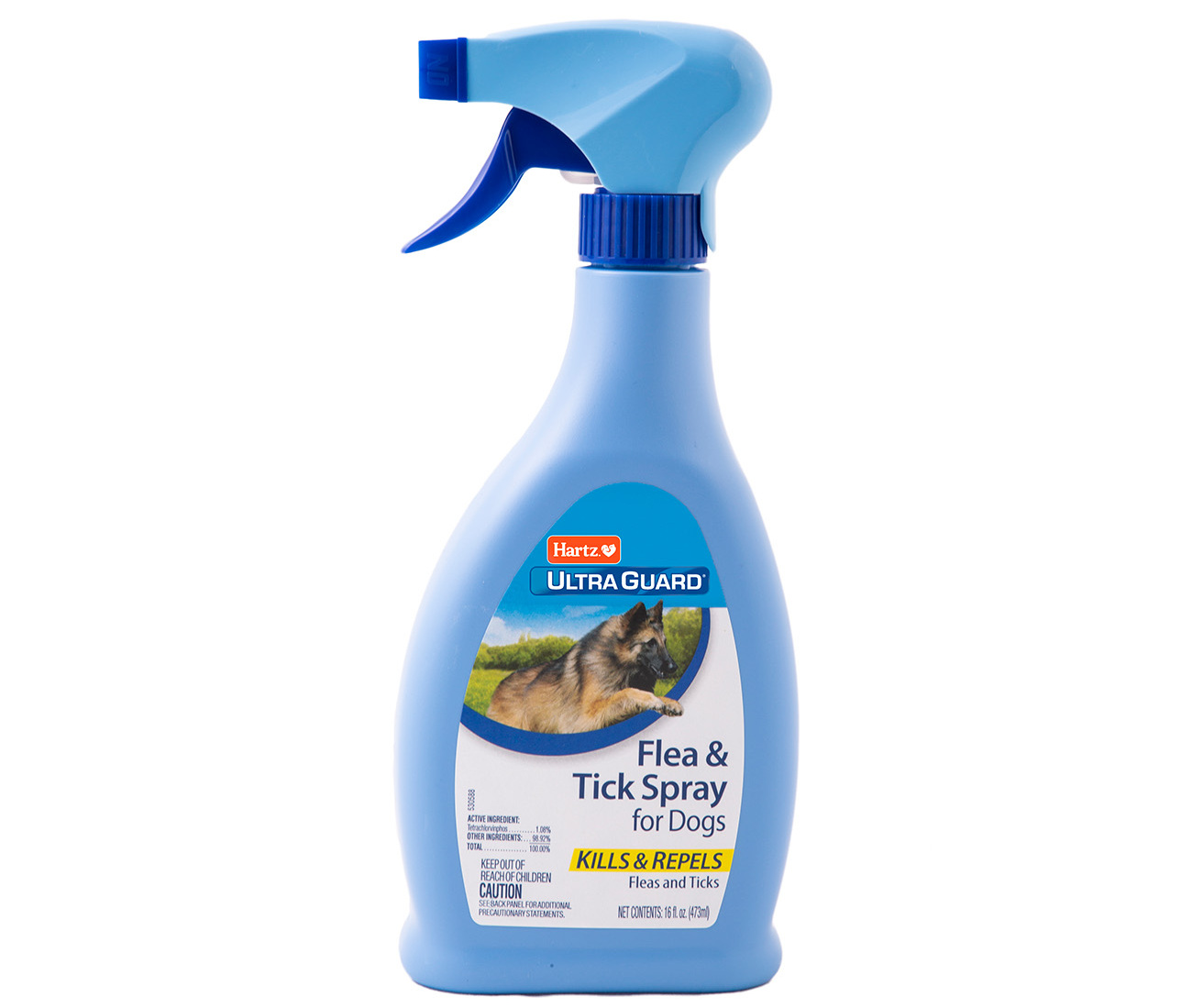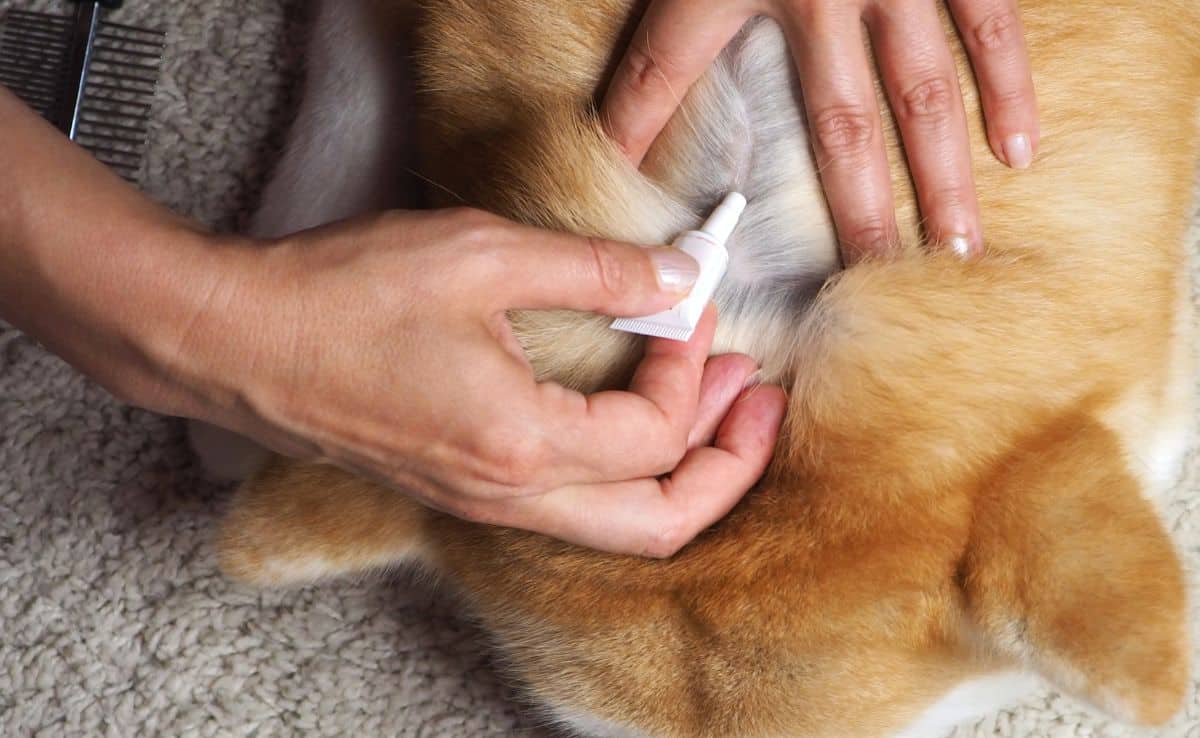Home>Health & Wellness>Common Health Issues>How To Treat Dogs With Ticks And Fleas


Common Health Issues
How To Treat Dogs With Ticks And Fleas
Published: February 16, 2024
Learn effective ways to treat dogs with ticks and fleas, two common health issues that can affect your pet's well-being. Discover the best remedies and prevention methods.
(Many of the links in this article redirect to a specific reviewed product. Your purchase of these products through affiliate links helps to generate commission for Pawsomeoldies.com, at no extra cost. Learn more)
Table of Contents
Introduction
Dealing with ticks and fleas is a common concern for dog owners. These pesky parasites not only cause discomfort for our furry friends but can also pose health risks. As a responsible pet owner, it's crucial to understand the implications of tick and flea infestations and be equipped with the knowledge to address these issues effectively.
Ticks and fleas are more than just a nuisance; they can transmit diseases such as Lyme disease, ehrlichiosis, and anaplasmosis to dogs. These illnesses can lead to a range of symptoms, from mild discomfort to severe health complications. Therefore, it's essential to take proactive measures to protect our canine companions from these tiny yet troublesome creatures.
In this comprehensive guide, we will delve into the world of ticks and fleas, exploring their characteristics, the signs and symptoms of infestation, treatment options, and preventive measures. By gaining a deeper understanding of these common health issues, you'll be better equipped to safeguard your dog's well-being and ensure a happy, healthy life for your beloved pet.
Read more: How To Treat A Dog With Fleas
Understanding Ticks and Fleas
Ticks and fleas are parasitic insects that thrive by feeding on the blood of animals, including dogs. Understanding the characteristics and behavior of these pests is crucial for effective prevention and treatment.
Ticks
Ticks are arachnids, belonging to the same family as spiders and scorpions. These tiny creatures have eight legs and vary in size, with some species as small as a pinhead and others as large as a pencil eraser when engorged with blood. Ticks are commonly found in grassy, wooded, or brush-filled areas, where they latch onto passing animals, including dogs, to feed on their blood.
Fleas
Fleas are small, wingless insects with flattened bodies, enabling them to move swiftly through the fur of their hosts. These parasites are adept at jumping, allowing them to transfer from one host to another with ease. Fleas thrive in warm and humid environments, making them prevalent in many regions. Once they infest a dog, fleas can quickly multiply, leading to a widespread and challenging infestation.
Life Cycle
Both ticks and fleas undergo a metamorphosis, progressing through egg, larval, pupal, and adult stages. Understanding their life cycle is essential for effective control. Ticks typically have a three-host life cycle, requiring a blood meal at each stage of development. In contrast, fleas have a four-stage life cycle, with the adult fleas feeding on the blood of the host animal.
Health Risks
In addition to causing discomfort and irritation, ticks and fleas can transmit a variety of diseases to dogs. Lyme disease, anaplasmosis, ehrlichiosis, and Rocky Mountain spotted fever are among the illnesses that ticks can transmit. Fleas can also transmit diseases such as bartonellosis and tapeworm infestations. These health risks highlight the importance of proactive prevention and prompt treatment of tick and flea infestations.
Understanding the biology and behavior of ticks and fleas is crucial for effectively managing and preventing infestations. By gaining insight into these parasites, dog owners can take proactive measures to protect their pets and maintain a safe and healthy environment for their beloved canine companions.
Signs and Symptoms
Recognizing the signs and symptoms of tick and flea infestations is essential for prompt intervention and effective management. Dogs may exhibit various indicators of infestation, signaling the presence of these troublesome parasites. By staying vigilant and observant, pet owners can identify potential issues early on and take the necessary steps to address them.
Signs of Tick Infestation
Ticks can latch onto a dog's skin, particularly in areas with less hair, such as the ears, groin, and armpits. Detecting ticks on a dog's body may require a close inspection, as these parasites can be small and easily overlooked. Common signs of tick infestation in dogs include:
- Visible ticks on the skin, resembling small, dark bumps
- Skin irritation or inflammation at the site of attachment
- Excessive scratching or licking of specific areas
- Presence of tick bite wounds or scabs
- Unexplained lethargy or weakness
Symptoms of Flea Infestation
Fleas are notorious for causing intense itching and discomfort in dogs. These persistent parasites can trigger a range of symptoms, indicating their presence on a dog's body. Recognizing the following signs can help identify a flea infestation in dogs:
- Excessive scratching, biting, or chewing of the skin
- Presence of flea dirt (dark, pepper-like specks) in the fur
- Redness or inflammation of the skin, particularly around the base of the tail and abdomen
- Hair loss or hot spots resulting from persistent scratching
- Allergic dermatitis, leading to skin irritation and discomfort
Read more: How To Treat Cancer In Dogs
Secondary Health Complications
In addition to the visible signs and symptoms of tick and flea infestations, dogs may experience secondary health complications as a result of these parasites. Tick-borne diseases, such as Lyme disease and ehrlichiosis, can manifest in symptoms such as fever, joint pain, and lethargy. Flea infestations can lead to anemia, particularly in young or small dogs, due to the blood loss caused by persistent feeding of fleas.
By remaining attentive to these signs and symptoms, dog owners can promptly address tick and flea infestations, minimizing the discomfort and health risks associated with these parasites. Early detection and intervention are crucial for ensuring the well-being of dogs and maintaining a harmonious coexistence with our beloved canine companions.
Treatment Options
When it comes to addressing tick and flea infestations in dogs, several treatment options are available to effectively eliminate these pesky parasites and alleviate the associated discomfort. It's essential for dog owners to explore the various approaches and choose the most suitable treatment based on the severity of the infestation and the individual needs of their canine companions.
Topical Treatments
Topical treatments, such as spot-on solutions and sprays, offer a convenient and targeted approach to combating ticks and fleas. These products are applied directly to the dog's skin, typically between the shoulder blades, where they provide long-lasting protection against parasites. Topical treatments work by disrupting the life cycle of ticks and fleas, preventing their reproduction and ultimately leading to their elimination.
Oral Medications
Oral medications provide an effective method for controlling tick and flea infestations in dogs. These medications come in the form of chewable tablets or flavored treats, making administration hassle-free for pet owners. Oral medications work systemically, circulating in the dog's bloodstream to kill ticks and fleas upon contact. They offer a convenient and efficient solution for managing infestations, particularly in dogs that may resist topical treatments.
Read more: How To Use Frontline Flea And Tick For Dogs
Shampoos and Dips
Bathing dogs with specialized tick and flea shampoos or dips can help eliminate existing parasites and provide temporary relief from itching and irritation. These products contain active ingredients that target ticks and fleas, effectively removing them from the dog's coat. While shampoos and dips offer immediate results, they may need to be used in conjunction with other long-term preventive measures for comprehensive protection against future infestations.
Collars
Tick and flea collars are designed to provide continuous protection against parasites. These collars release active ingredients that repel and kill ticks and fleas, creating a shield around the dog's neck and upper body. Collars are a convenient and low-maintenance option for long-term prevention, offering sustained protection against infestations. However, it's important to select collars with proven effectiveness and consider potential sensitivities in some dogs.
Environmental Treatments
In addition to directly treating dogs, addressing the environment is crucial for comprehensive tick and flea control. Environmental treatments involve targeting areas where ticks and fleas may reside, such as bedding, carpets, and outdoor spaces. Using environmental sprays, powders, or foggers can help eliminate parasites in the surroundings, reducing the risk of reinfestation and creating a safer living environment for dogs.
Consultation with a Veterinarian
When determining the most suitable treatment for tick and flea infestations, consulting a veterinarian is highly recommended. Veterinarians can assess the severity of the infestation, consider any underlying health conditions in the dog, and provide personalized recommendations for effective treatment. Additionally, veterinarians can offer guidance on preventive measures to minimize the risk of future infestations, ensuring the long-term well-being of dogs.
By exploring these treatment options and considering the specific needs of their dogs, pet owners can take proactive steps to address tick and flea infestations effectively. It's important to prioritize the comfort and health of our canine companions, and by choosing the appropriate treatment approach, dog owners can ensure a safe and parasite-free environment for their beloved pets.
Prevention Tips
Preventing tick and flea infestations is a proactive approach that plays a pivotal role in safeguarding the well-being of dogs and maintaining a harmonious living environment. By implementing comprehensive preventive measures, pet owners can minimize the risk of infestations and create a safe, parasite-free space for their beloved canine companions.
Regular Grooming
Regular grooming practices, including brushing and combing, are essential for detecting and removing ticks and fleas from a dog's coat. This allows for early intervention and helps prevent infestations from taking hold. Additionally, maintaining a clean and well-groomed coat can deter parasites from latching onto the dog's fur.
Use of Preventive Products
Utilizing preventive products, such as monthly spot-on treatments, oral medications, or tick and flea collars, can provide ongoing protection against parasites. These products disrupt the life cycle of ticks and fleas, preventing infestations and ensuring the dog remains free from these troublesome pests.
Environmental Management
Regularly cleaning and treating the dog's living environment is crucial for preventing infestations. Washing bedding, vacuuming carpets, and using pet-safe environmental sprays can help eliminate ticks and fleas in the surroundings. Additionally, maintaining outdoor spaces by mowing the lawn and clearing debris can reduce the risk of exposure to parasites.
Regular Veterinary Check-ups
Scheduling routine veterinary check-ups allows for comprehensive health assessments and preventive care. Veterinarians can recommend suitable tick and flea prevention products based on the dog's individual needs and provide guidance on maintaining a parasite-free environment.
Avoiding Tick-Prone Areas
When engaging in outdoor activities with dogs, it's advisable to avoid tick-prone areas such as tall grass, wooded areas, and dense vegetation. Staying on designated paths and trails can minimize the risk of encountering ticks and reduce the likelihood of infestations.
Early Intervention
Promptly addressing any signs of tick or flea infestations is crucial for preventing the spread of parasites. If ticks or fleas are detected, immediate treatment and thorough removal of the parasites can prevent the infestation from escalating.
Education and Awareness
Educating oneself about the habits and habitats of ticks and fleas can empower pet owners to take proactive measures. Understanding the seasonal variations in parasite activity and being aware of preventive strategies can contribute to effective tick and flea control.
By incorporating these preventive tips into their routine care practices, dog owners can create a protective shield against tick and flea infestations. Proactive prevention not only ensures the comfort and well-being of dogs but also fosters a healthy and thriving bond between pets and their owners.
Read more: How Do Dog Collars For Fleas And Ticks Work
Conclusion
In conclusion, addressing tick and flea infestations in dogs is a crucial aspect of responsible pet ownership. By gaining a comprehensive understanding of these common health issues, dog owners can effectively safeguard their pets from the discomfort and health risks associated with ticks and fleas. The insights provided in this guide shed light on the characteristics of ticks and fleas, the signs and symptoms of infestation, treatment options, and preventive measures, empowering pet owners to take proactive steps in ensuring the well-being of their canine companions.
Understanding the biology and behavior of ticks and fleas is fundamental for implementing targeted preventive strategies. By recognizing the signs and symptoms of infestation, such as visible parasites, skin irritation, and excessive scratching, dog owners can promptly intervene and seek appropriate treatment. Additionally, being aware of the potential health risks posed by ticks and fleas, including the transmission of diseases, underscores the importance of proactive prevention and vigilant monitoring of dogs.
Exploring the diverse treatment options, including topical treatments, oral medications, shampoos, dips, collars, and environmental treatments, provides dog owners with a range of approaches to address infestations effectively. Moreover, consulting with a veterinarian for personalized guidance and recommendations ensures that the chosen treatment aligns with the specific needs and health status of the dog.
Preventive measures, such as regular grooming, the use of preventive products, environmental management, veterinary check-ups, and education about tick and flea habits, form a comprehensive approach to minimizing the risk of infestations. By integrating these preventive tips into their routine care practices, dog owners can create a protective shield against ticks and fleas, fostering a safe and comfortable environment for their beloved pets.
Ultimately, the well-being of dogs is at the heart of addressing tick and flea infestations. By prioritizing proactive prevention, early intervention, and informed decision-making, pet owners can ensure that their canine companions lead healthy, vibrant lives free from the perils of these persistent parasites. Through knowledge, vigilance, and compassionate care, dog owners can embark on a journey of responsible pet ownership, nurturing a bond of trust, comfort, and well-being with their beloved dogs.









